Читать книгу Distributed Acoustic Sensing in Geophysics - Группа авторов - Страница 37
2.2. FIBER‐OPTIC SENSOR 2.2.1. Sensing from Backscattered Light
ОглавлениеAt the center of DAS technology is the fiber‐optic cable deployed in one of several ways as the seismic sensor. Unlike seismometers that are thought of as point sensors, a fiber‐optic cable senses strain along the entire fiber, which can be thousands of kilometers long. Because individual sensors do not make the measurement, it is referred to as a “distributed sensor measurement.” For ordinary telecommunication applications, a laser generates encoded light signals that pass information along the fiber to a distant receiver. Small defects or changes in the optical properties of the fiber along its length cause the light to be backscattered toward the laser source. The fiber is designed to minimize, by five to seven orders of magnitude as compared to the illuminating light, the amount of attenuation and backscattered light, so that data can be transmitted over large distances. However, this same unwanted backscattered light in telecommunications is used for DAS applications to detect and characterize local changes in the strain of the optical fiber from acoustic and seismic signals as well as from temperature changes.
When seismic waves or small temperature transients mechanically deform an optical fiber, the optical propagation properties of the fiber change, causing extremely small time delays during the travel path of the backscattered light. When a pulse of laser light is introduced into one end of the fiber, these small changes in the optical properties of the fiber create a continuous “shower” of scattered light emanating from virtually all points along the fiber as the pulse passes through. The timing change of the backscattered light forms the basis by which the strain, or deformation, of the fiber can be measured using an optical interrogation system.
